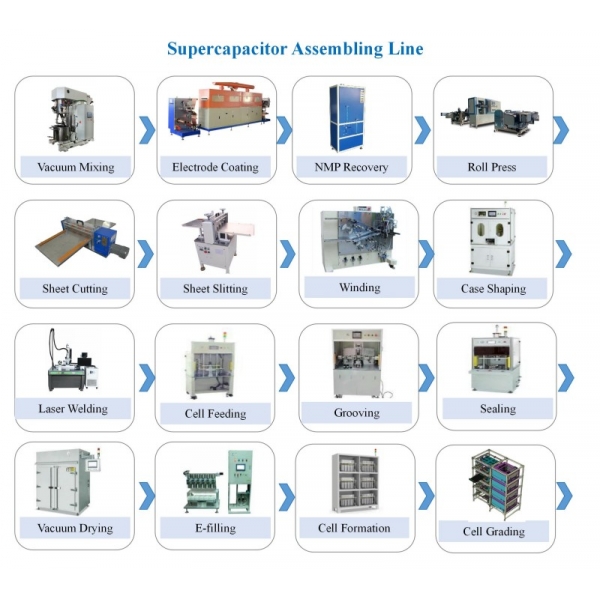- Отправить по электронной почте : David@tmaxcn.com
- Отправить по электронной почте : Davidtmaxcn@gmail.com
- : No. 39, Xinchang Road, Xinyang, Haicang Dist., Xiamen, Fujian, China (Mainland)
Xiamen Tmax Battery Equipments Limited was set up as a manufacturer in 1995, dealing with lithium battery equipments, technology, etc. We have total manufacturing facilities of around 200000 square foot and more than 230 staff. Owning a group of experie-nced engineers and staffs, we can bring you not only reliable products and technology, but also excellent services and real value you will expect and enjoy.
Supercapacitor Fabrication Equipment: Enabling HighQuality Energy Storage Solutions
Supercapacitor fabrication equipment refers to the specialized machinery and systems used to manufacture supercapacitors, from raw material preparation to final assembly. These systems are designed to handle delicate materials, ensure precise alignment during assembly, and produce supercapacitors with consistent performance. By automating and optimizing the fabrication process, this equipment enables mass production while maintaining highquality standards.
In this article, we will explore the structure, functionality, advantages, challenges, and innovations associated with supercapacitor fabrication equipment.
●What Is Supercapacitor Fabrication Equipment?
Supercapacitor fabrication equipment consists of machines and tools that automate the entire process of supercapacitor manufacturing. It is used to handle materials, assemble components, and test the final product. Whether for laboratoryscale prototyping or industrialscale production, this equipment plays a critical role in advancing the development and commercialization of supercapacitors.
The primary goal of supercapacitor fabrication equipment is to enable efficient, costeffective, and scalable production of highperformance supercapacitors for various applications.
●Key Components of Supercapacitor Fabrication Equipment
A typical supercapacitor fabrication setup includes several interconnected modules:
1. Material Preparation Module
Prepares active materials (e.g., activated carbon, graphene), binders, conductive additives, and current collectors.
Mixes slurries uniformly using advanced mixing techniques to ensure homogeneity.
2. Electrode Coating and Drying Module
Applies the prepared slurry onto current collector foils (e.g., aluminum or nickel) using techniques like slot die coating, doctor blade coating, or spray coating.
Dries the coated foil under controlled conditions to form solid electrodes with precise thickness and density.
3. Cutting and Tab Welding Module
Cuts the dried electrodes into predefined dimensions using laser cutting or mechanical dies.
Attaches current collector tabs to the electrodes via resistance welding, ultrasonic welding, or laser welding.
4. Cell Assembly Module
Stacks or winds electrodes with separators to create the core assembly.
Ensures proper alignment and spacing between layers for optimal ion movement.
5. Housing Insertion and Sealing Module
Places the assembled core into a prefabricated housing or casing.
Seals the housing using heat sealing, laser welding, or ultrasonic welding to prevent contamination and electrolyte leakage.
6. Electrolyte Injection Module
Injects liquid electrolyte into the sealed housing under controlled conditions.
Avoids air bubbles and ensures complete wetting of electrodes.
7. Formation and Activation Module
Charges and discharges the cells under controlled conditions to activate their electrochemical properties.
Enhances capacitance and reduces internal resistance.
8. Testing and Quality Control Module
Conducts rigorous tests to verify capacitance, internal resistance, leakage current, safety, and durability.
Identifies defective units and ensures only highquality supercapacitors pass inspection.
9. Packaging Module
Packages finished supercapacitors for shipping or integration into end products.
●Processes Performed by Supercapacitor Fabrication Equipment
The equipment performs the following key processes:
1. Material Preparation: Mixing slurries and preparing electrodes.
2. Core Assembly: Stacking or winding electrodes with separators.
3. Sealing: Encasing the core assembly in a hermetic housing.
4. Electrolyte Injection: Filling the housing with electrolyte.
5. Formation: Activating the electrochemical properties of the cell.
6. Quality Testing: Verifying performance metrics and ensuring compliance with standards.
7. Packaging: Preparing the final product for delivery.
●Advantages of Supercapacitor Fabrication Equipment
1. High Precision:
Automated systems ensure accurate alignment and placement of components, reducing defects and improving performance.
2. Increased Efficiency:
Faster production rates compared to manual assembly, enabling higher throughput and reduced labor costs.
3. Consistent Quality:
Eliminates variability caused by human error, ensuring uniformity across all manufactured units.
4. Cost Savings:
Reduces material waste and rework due to precise handling and realtime quality checks.
5. Scalability:
Can be configured for smallscale prototyping or largescale mass production, depending on demand.
6. Safety Enhancements:
Minimizes human exposure to hazardous materials like electrolytes and sharp components.
●Challenges in Supercapacitor Fabrication Equipment
Despite its benefits, supercapacitor fabrication equipment faces certain challenges:
1. Complex Integration:
Coordinating multiple modules and processes requires advanced engineering and software control systems.
2. Material Handling:
Handling delicate materials like thin electrodes and porous separators without causing damage is challenging.
3. Sealing Integrity:
Ensuring reliable seals that withstand repeated chargedischarge cycles and environmental conditions is critical but difficult.
4. High Initial Costs:
Advanced automation and precision machinery come with significant upfront investment.
5. Adaptability to New Technologies:
Rapid advancements in supercapacitor materials and designs require frequent upgrades to keep equipment uptodate.
Supercapacitor Pilot Line Equipment
●Innovations in Supercapacitor Fabrication Equipment
To address these challenges and enhance productivity, manufacturers are incorporating cuttingedge technologies:
1. Advanced Sensors and Vision Systems:
Realtime monitoring of component alignment, sealing quality, and overall assembly ensures consistent output.
2. AI and Machine Learning:
Predictive analytics optimize machine performance, detect anomalies, and improve yield rates.
3. Modular Design:
Flexible systems allow for easy reconfiguration to test new materials, chemistries, and cell designs.
4. Sustainability Features:
Ecofriendly practices minimize waste and energy consumption during the fabrication process.
5. SolidState Adaptation:
Future equipment will be designed to handle solidstate electrolytes, enabling safer and more efficient nextgeneration supercapacitors.
6. Collaborative Robotics:
Humanmachine collaboration enhances flexibility and adaptability in production processes.
●Applications of Supercapacitor Fabrication Equipment
Supercapacitor fabrication equipment is used in a wide range of industries, including:
1. Consumer Electronics:
Produces compact supercapacitors for smartphones, wearables, and portable devices.
2. Automotive Industry:
Manufactures highpower supercapacitors for hybrid and electric vehicles, regenerative braking systems, and auxiliary power units.
3. Renewable Energy:
Creates durable supercapacitors for energy storage applications in solar panels, wind turbines, and grid stabilization systems.
4. Industrial Equipment:
Generates robust supercapacitors for heavy machinery, cranes, elevators, and other industrial applications.
5. Medical Devices:
Develops reliable supercapacitors for implantable devices, diagnostic tools, and wearable health monitors.
●The Future of Supercapacitor Fabrication Equipment
As the demand for advanced energy storage solutions grows, supercapacitor fabrication equipment will continue to evolve. Key trends shaping the future include:
1. Increased Automation:
Fully autonomous systems will further boost production speeds and reduce costs.
2. Customization Options:
Modular designs will enable manufacturers to tailor equipment for specific cell types and chemistries.
3. Focus on Sustainability:
Ecofriendly practices and recycling capabilities will become integral parts of future equipment.
4. Integration with Emerging Technologies:
Solidstate supercapacitors, flexible electronics, and autonomous systems will drive new innovations in fabrication processes.
5. Smart Manufacturing:
IoTenabled equipment will leverage big data and AI to optimize production, reduce waste, and enhance efficiency.
●Conclusion
Supercapacitor fabrication equipment is essential for advancing the field of energy storage by automating and optimizing the production of highperformance supercapacitors. It provides precision, consistency, and efficiency while reducing costs and minimizing waste.
What excites you most about the role of fabrication equipment in supercapacitor development? Share your thoughts below! Together, let’s explore how this equipment can drive innovation and sustainability in the energy storage sector.
 ru
ru English
English











 Iris@tmaxcn.com
Iris@tmaxcn.com David@tmaxcn.com
David@tmaxcn.com +86 13174506016
+86 13174506016
